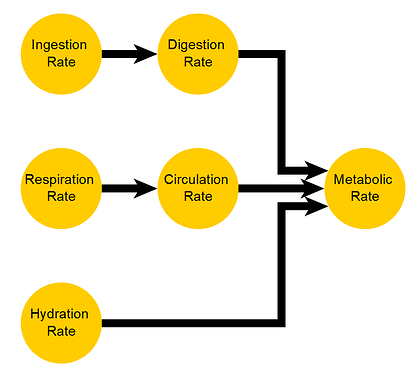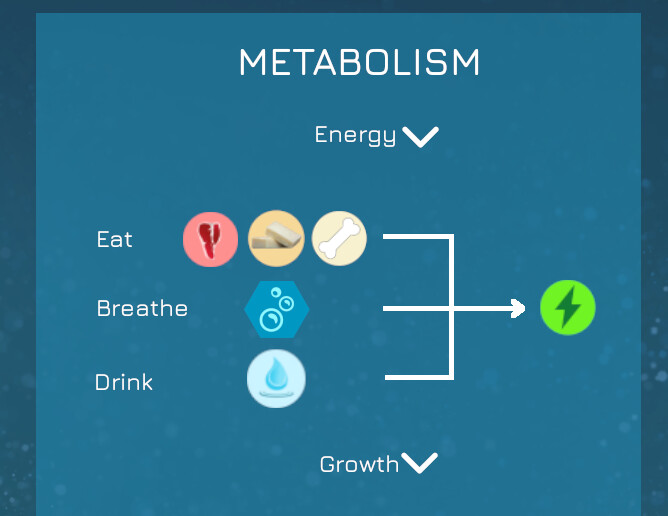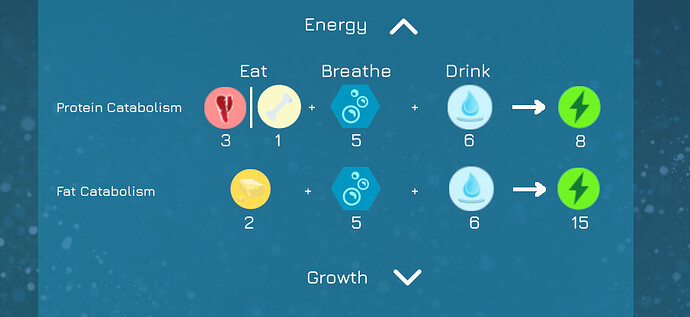Background
I’ve been wondering a lot about the transition from microscopic to macroscopic, and how we will design gameplay as an early 3D organism. We have a very good understanding of what Microscopic organisms function like, but the concept for Macroscopic organisms is more murky. We have vague ideas like that we want the player to be able to place organs like hearts, lungs, stomachs, etcetera. But this raises so many questions:
- What do these organs do?
- How do they work together?
- Can an organism evolve the highest level heart possible without ever evolving a lung?
- And how do we make it possible for simple organisms to not even have a heart? Or not even have a stomach?
- And how do we design this in such a way that it feels like a natural continuation from what you played through during microscopic gameplay?
I recently came up with an idea to address all of this called the Metabolic Rate System. I would usually keep this in my notes and save it for later when this topic comes up, but I feel like it actually ties into some gameplay features we have planned (such as the Diffusion Rate trait I’ve discussed before). So I want to bring it up, explain what I think makes it worthwhile, and how it would impact our future game design if accepted.
Pitch
There will be a new trait called Metabolic Rate. This represents the total amount of energy that the organism can produce in any given second. Think of the organism like a power plant, and their Metabolic Rate is the total electricity they can produce per second. Metabolic Rate will be used to determine a creature’s top speed, strength, stamina, and many other variables. It will almost be like ATP in the microscopic stages.
However, for a creature to produce energy, they must consume food, water, and gas. So we will add in traits like Circulation Rate (the rate at which gas is circulated to the tissues), Hydration Rate (the rate at which water is absorbed by the creature) and Digestion Rate (already exists. The rate at which food is absorbed by the creature). ALL THREE of these rates will be needed to maintain a creature’s metabolism, therefore the Metabolic Rate will be calculated as the LOWEST of these three rates of a creature.
One extra layer: Digestion Rate and Circulation Rate will both depend on another rate themselves. Ingestion Rate will represent how quickly an organism can consume food, which is then passed over to digestion. Respiration Rate determines how quickly an organism can absorb gas, which is then passed over to the blood for circulation. Both Digestion Rate and Circulation Rate will be limited by Ingestion Rate and Respiration Rate, respectively.
Therefore, the final chart comes out to be:
If any of these three components of the Metabolic Rate ceases, an organism will begin to die. Therefore, a creature can die of dehydration (Hydration Rate at 0), starvation (Digestion Rate at 0), or suffocation (Circulation Rate at 0).
A creature can of course stock up on a certain resource so that they do not need to constantly produce it. A filter feeder may constantly be ingesting food, but a predator may have an irregular eating pattern. Instead it does not eat for a while, then catches a big prey which lets him consume a lot of food all at once and store it, slowly digesting it and feeding its metabolism until he can find his next prey.
This system is also very flexible to different metabolisms. The metabolism of a creature defines what rate it needs of each component. Some creatures may not need to eat at all, surviving purely off of water and gas. Some creatures may survive on a different fluid than water, but we will still refer to it as hydration. Different foods (plants, meat, inorganic material) will all fall under food that is consumed under the Digestion Rate component.
Consequences
- It gives a function for the many different digestive, circulatory, and respiratory organs we want the player to be able to place in the Organism Editor.
- In nature, the digestive, circulatory, and respiratory systems are highly linked. This is the only realistic way I can think of of tying all three systems together. A name I’ve seen mentioned is the “Gastrovascular System” to refer to these three systems working together.
- It creates natural bottle-necks that means that you can’t evolve one part of your Gastrovascular System too far without making sure other parts are appropriately evolved. For example, a larger heart is useless if you cannot feed it with more gas, which may require you to first evolve gills before you grow your heart. Perhaps a small aquatic creature has no problems with hydration and circulation, so if he wants to increase his metabolism only digestive system mutations would be useful. This is actually very realistic, as when we look at nature we see that species have always had to evolve their Gastrovascular System in this stepwise process.
- It ties in well with the Microbe Stage. Diffusion Rate is already a trait I’ve suggested before that should be added, AKA a variable rate at which a cell can absorb compounds from the environment. This would effectively be the Respiration Rate.
- Because multicellular life starts simple and underwater, most of this chart would not apply at first. Hydration Rate would always be filled because the creature would be surrounded by water which will constantly flow into their organs via their skin (until they evolve thicker skin that cannot do this). They will have no circulatory system, so their respiratory rate will translate straight into metabolic rate. They will have no digestive system, so their ingestion rate will flow right into their metabolic rate. So it will just be 2 nodes feeding into 1 node, and progressively become a more complex tree as the creature evolves to become more complex.
- It allows for simple life to never evolve some of these systems. A creature can ingest food via its skin, and respire via its skin. Therefore such a creature will never need to evolve a heart or a stomach or an intestine.
- This will naturally produce a barrier for aquatic organisms to adapt to living on land, since living underwater will provide them with a constant flow of water and living on land will suddenly take that away. So creatures will have to evolve a means of finding and storing water on land if they want to survive there.
- With this system in place, there are few other systems needed to implement all the remaining organ types. Reproductive organs are straightforward enough. Endocrinal organs will be a part of the Agent System. Integumentary Parts (skin, fur, scales, horns, spikes, shells) only confer bonuses to existing traits (physical defence, chemical defence, speed, etc.). Muscles and skeletons are also straightforward enough. It’s only really the Nervous organs and the Sensory organs that may need an extra system or two to give them purpose.
Applications
Here are examples of how the many planned organs (weird to say this for once instead of organelles) can have a use now with such a system:
- Gill Slits: Increases ingestion rate of filter feeding while swimming by 50%. Increases respiration rate while swimming by 10%.
- Gills: Increases respiration rate while swimming by 50%.
- Blood: Enables Circulation Rate (base rate is 100). Increases Respiration Rate by 100%.
- Aorta (Simple Heart): Increases Circulation Rate by 100%.
- Gastrovascular Cavity (Simple Mouth/Stomach): Reduces Digestion Speed by 50%, but increases nutrients yielded by digestion by 100%.
Next Steps
- If it’s agreed that such a system makes sense, I can document it on the wiki for future reference.
- We can look at how the Microbe Stage should transition into this system. Perhaps we could make the traits in the Microbe Stage renamed to match these names to make it more of a seamless transition?



